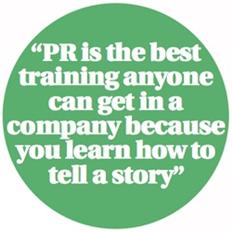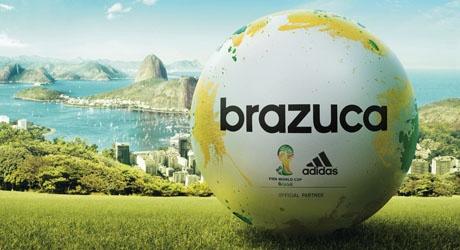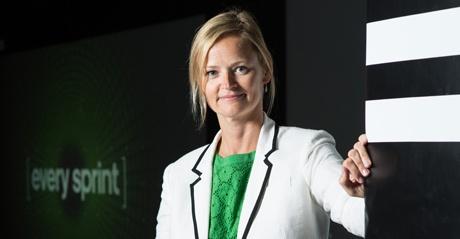Adidas: aiming to score in Brazil
With the World Cup just a year away, sponsor Adidas is gearing up its marketing but faces tough competition from Brazilian team partner Nike. Senior vice-president of global marketing Nicole Vollebregt explains how her brand aims to win.
“The Brazilian people and Adidas have something very much in common,” claims Nicole Vollebregt, senior vice-president of global brand marketing at Adidas. “It’s called ‘football first’. They’re the football nation and we’re the football brand and that shared passion is something we’re really trying to tap into for 2014.”
With the World Cup just a year away, Vollebregt is carefully planning Adidas’s marketing vision for the upcoming football fiesta in Latin America. As a Fifa partner and sponsor of next year’s tournament, the sportswear brand is seeking to draw on the vibrant Samba style of the host nation and build on its success at the last global sporting showcase, the London 2012 Olympics.

For Vollebregt, a Canadian with Dutch parents who has worked at Adidas for 16 years, such events are crucial stepping stones in the continued development of the €11.3bn (£9.6bn)brand. “The World Cup is a signpost that we always use as our next goal and every time we want to be better,” she says. “We want to bring out better products, improve our sales and improve our market share. This one is no different.”
But despite the brand’s size and status, success for Adidas continues to be defined by the comparative performance of its rival Nike. A recent study of the two brands by market analysis firm Trefis suggests that Nike is outpacing Adidas in the important sports apparel market, with sales up 12 per cent over the past two years at the US corporation compared with 8 per cent at its German counterpart.
Although the Adidas figure covers the entire group – including the struggling Reebok brand, which Adidas acquired in 2005 – Trefis confidently predicts that “Nike’s apparel sales will continue to grow rapidly in the future, driven by an innovative product portfolio, superior market position and enhanced marketing activities”.
The tussle between the two giants will continue in Brazil, where Adidas will benefit from being an official World Cup sponsor but where Nike is the sportswear partner of the Brazilian national team. It could also be argued that Nike’s more flamboyant brand attributes are better suited to the sights and sounds of Brazil than the more formal and efficient values for which Adidas is traditionally known.
Vollebregt, however, dismisses this view and suggests that Adidas is already honing its more youthful and fun-loving side ahead of next year’s tournament. “Our brand can be serious when we talk about innovations but that’s changing and we’re becoming less rigid in the way we present the brand – a lot younger and a lot fresher,” she says. “We’re about cutting-edge football now and presenting that in every way it means.”
Marketing Week met Vollebregt at Adidas Lab, the first in a series of events for fans and journalists aimed at showing off the brand’s latest technology. The event in central London, which saw Adidas unveil a digitally connected ‘smart’ football among other innovations, is further proof that the brand’s dominance is going beyond just apparel and equipment and into the realms of how sport itself is perceived and played.

“We’ve not been shy here in showing things that are coming a bit further into the future,” notes Vollebregt. “It’s exciting for us to be able to share that and show where we’re heading as an industry.”
This self-confidence is unsurprising in light of the brand’s enduring strength and growth. Last year, sales of Adidas-branded goods surged by 10 per cent as the Olympics – of which Adidas was a sponsor – and emerging markets helped to fuel worldwide expansion. While sales in Western Europe rose by 3 per cent, in Latin America growth was 8 per cent and in China 15 per cent.
Adidas’s Take the Stage campaign for London 2012, which celebrated urban culture and its connection to sport, is evidence of the brand’s efforts to speak to a young demographic around the world in the terms and formats they appreciate. Vollebregt says Adidas aims to build on this approach for next year’s World Cup, including by developing its rapidly growing presence on social media (see Looking to Brazil, page 18).
“We really did reach a younger audience [at London 2012], partly through our creative approach but also through the media approach,” she says. “What the UK team did, particularly in social media, is very much the blueprint for what we’ll be doing for the World Cup.”
Vollebregt believes Adidas will also benefit from the diversity of its product range, allowing it to present itself in Brazil as both a sports brand and a lifestyle brand. In recent years, Adidas has focused on growing its style division, which includes the streetwise Adidas Originals line, in order to broaden its demographic appeal with a diverse mix of clothing.
“Originals is the perfect embodiment of what happens all around the pitch: the music, the street culture, the artistry,” says Vollebregt. “We’re able to cover off the 90 minutes on the pitch but also what’s happening all around it. I think we’re in a unique position to encapsulate the whole essence of Brazil from pitch to street and this will be the first time you’ll see a World Cup effort from us that’s holistic – both sides of the brand from sport to style.”
The Originals sub-brand is particularly close to Vollebregt’s heart as she led marketing for the style division when it was set up in 2007. Vollebregt, who had previously spent 10 years in various PR roles at Adidas, oversaw the first TV campaigns for Originals, including a ‘house party’ spot in 2009 that featured the likes of David Beckham, Katy Perry and Missy Elliott.
Vollebregt speaks with particular pride about this side of the business, noting that Originals now accounts for more than €2.5bn in annual revenue. She says: “When we launched the style division I knew it was an amazing opportunity to really stretch the breadth and depth of what Adidas could mean and reach so many new consumers that we didn’t reach before.”

Brazilian football fans selected the name Brazuca for the official World Cup ball following an online poll by Adidas
Vollebregt’s career history is tied closely to the recent evolution of the Adidas brand. After a few years working in the style division, she and a colleague pitched the idea of running an ‘All In’ campaign that would bring together the sportswear and lifestyle sides of the brand. The Adidas board approved the idea and in 2011, brand marketing was consolidated into a single team. Vollebregt was asked to head the department as senior vice-president of global brand marketing.
These changes have helped Adidas mix the different strands of sport performance, lifestyle and fashion under a single brand. All In remains central to the brand’s global positioning and appears as a tagline in several campaigns and activations, although Adidas continues to use variations of its three-stripes logo for different sub-brands, including the ‘Trefoil’ design for Originals.
Vollebregt believes the “halo” effect of the All In positioning has helped Adidas to strengthen brand loyalty and gain an advantage over competitors. “It’s exciting because you start to build a brand around advocacy and one-to-one relationships with consumers,” she says. “When somebody interacts with our brand, be it online or in a retail store, you have the opportunity to offer them so much more than any one single brand.”
She adds that despite the breadth of what Adidas produces, certain terms remain central across the brand such as ‘authentic’ and ‘passion’. “We’ve been able to grow every part of the business, creating enough differentiation between the different parts but still having a DNA across the whole brand that’s always rooted in sport and still speaks to what Adidas is.”
Although Vollebregt has witnessed big changes at Adidas during her 16 years with the business, she has also seen evolutions in the wider sportswear market. Adidas and Nike have strengthened their dominance in a number of key markets, for example, as once popular brands such as Umbro, Fila and Le Coq Sportif have fallen by the wayside.
At the same time, traditional fashion and lifestyle brands have sought to grow their presence in sportswear by challenging the established players. Vollebregt notes that “everyone from Prada to H&M is breaking into sport or trying to” by developing sportswear lines and signing athletes as brand ambassadors.
“It goes back to the convergence of sport, lifestyle and fashion because I think brands are realising that you can’t put consumers in a box – you need to be able to speak to all facets of their lives,” she says. “That’s something we were already doing but now we’re seeing other brands that want to break in by coming at [sportswear] from the fashion angle.”
To help fend off this challenge, Adidas is devoting more attention to its reputation for innovation in sport. In addition to events such as Adidas Lab, the brand is bringing its technological capabilities and sporting expertise to the fore in its advertising activity.
To coincide with the UEFA Champions League final last month, for example, Adidas ran an advert designed to tease fans with snippets of player performance data from the tournament. This was supported by a call to ask fans to make predictions about specific player stats during the final via an online hub where visitors could compete with Adidas ambassadors including footballers Gareth Bale and Fernando Torres.
The focus on sports statistics and data comes as Adidas prepares to roll out its new real-time data tracking system – miCoach Elite – across all Major League Soccer teams in the US next season. This system incorporates a small data pack that is fitted to the back of each player’s base layer. Connected by a series of electrodes and sensors woven into the fabric of the base layer, the pack wirelessly transmits more than 200 data records per second from each player to a central computer, which are displayed as insights for the pitch-side coaching team to view on a tablet.
Vollebregt argues that such applications are becoming increasingly important in elite-level sport and that by aiming to take the lead with this technology, Adidas is cementing its status as an authoritative all-round sports brand, rather than just a kit or equipment maker. “There is no innovation in football now that doesn’t involve data,” she says. “We want to be a bit louder about what we’ve been working on because it is very much going to be the future of football.”

Innovation is also central to Adidas’s biggest non-football product launch this year: the Boost running shoe. The trainer, which Adidas launched to build its share in running and athletics, promises to provide ‘the ultimate running experience’ thanks to ‘breakthrough cushioning’ in the soles.
As part of the marketing push for Boost, Adidas again turned to social media to broadcast and generate content and to raise awareness among runners. Vollebregt says that sales of Boost have already exceeded expectations in key markets such as the UK and US, with JD Sports running out of stock within a few weeks.
“We’re going to be rolling out Boost across different categories so you’ll be seeing a lot more of it,” she adds. “We believe we’re onto something here – the reaction from consumers but also from some of the toughest running critics has been very positive.”
As Boost demonstrates, PR, product reviews and word of mouth continue to have a major effect on Adidas’s sales. Vollebregt, who became Adidas’s global head of PR in 2006, says that experience has provided a solid grounding for the marketing position she now occupies.
“PR is probably the best training that anyone can get in a company because no matter what you end up doing, whatever the job is, in PR you learn how to tell a story,” she says. “Everything comes down to how good your story is and what you want to tell.”
In her current role, Vollebregt reports directly to Adidas chief marketing officer Hermann Deininger. His wide-ranging brief covers product, design and marketing while Vollebregt has oversight for all brand communications, or as she puts it, “any consumer interface with the brand”. She says the biggest challenge of her job is doing something different each time to ensure the brand stands out in a highly competitive marketplace.
“There are a lot of good companies with a lot of good ideas so the challenge is making sure that every idea we come up with hasn’t been done before,” she explains. “That means pushing everyone to think about how can we go into new territories, try something new and be brave.”
Another challenge, of course, is the unpredictability of sport – in particular the unpredictable behaviour of sports stars paid to represent the brand. This year alone, Adidas has been embarrassed by Sergio Garcia after the golfer aimed a racist jibe at Tiger Woods and by Luis Suarez, the Liverpool forward banned for 10 matches for attempting to bite an opponent.
Despite disapproving statements from Adidas, both men remain ambassadors for the brand. Although Vollebregt is understandably cagey about the brand’s stance on such issues, she points out that there is no rigid code of conduct for dealing with them. “There is no blueprint,” she says. “You have to treat every situation differently.”
This flexibility is, of course, down to the fact that sports brands depend on their stars to drive them forward. While Adidas will continue to push its technology credentials and its ‘street to pitch’ positioning, the brand will also be looking to football heroes such as Juan Mata, Arjen Robben and Lionel Messi to ensure it makes the biggest possible impact in Brazil next year.
Nicole Vollebregt CV
2011 to present Senior vice president of global brand marketing, Adidas
2007 to 2011 Vice president of global brand marketing, Adidas Style division
2006 to 2007 Head of global PR, Adidas
1998 to 2006 Head of PR, Adidas America
1997 to 1998 Global PR manager, Adidas Germany
Prior to joining Adidas
PR specialist at Manifest Communications, Toronto, Canada









